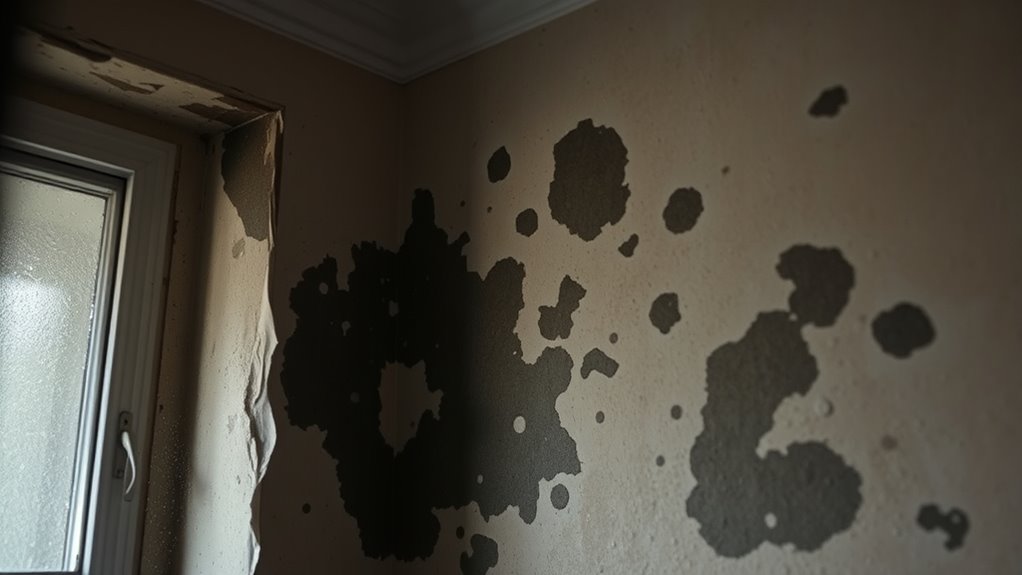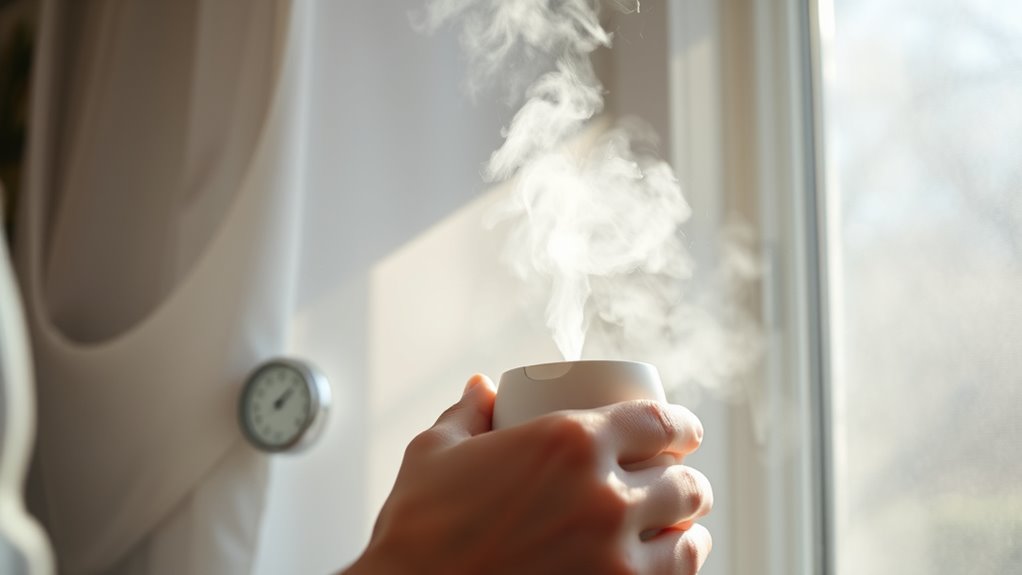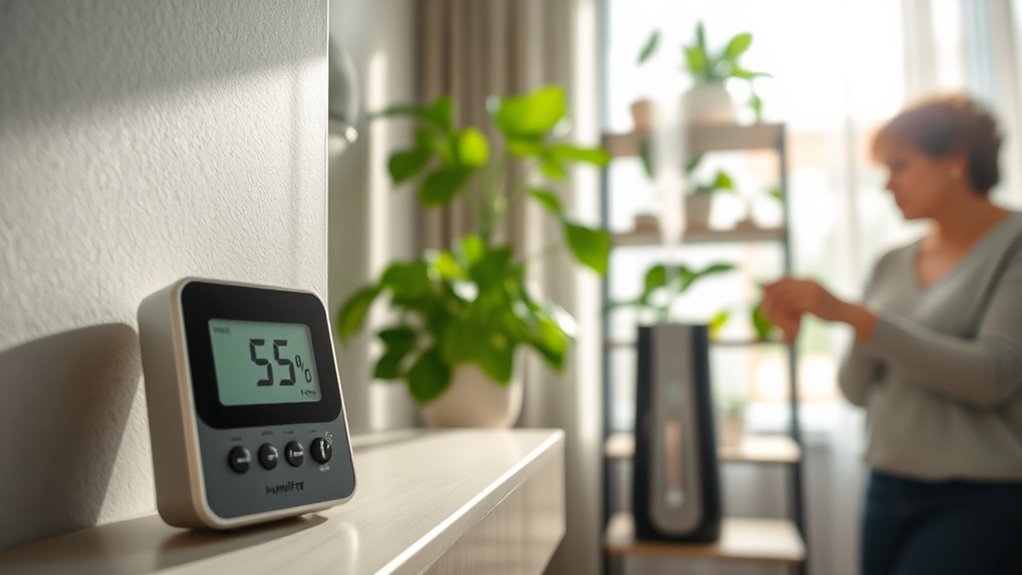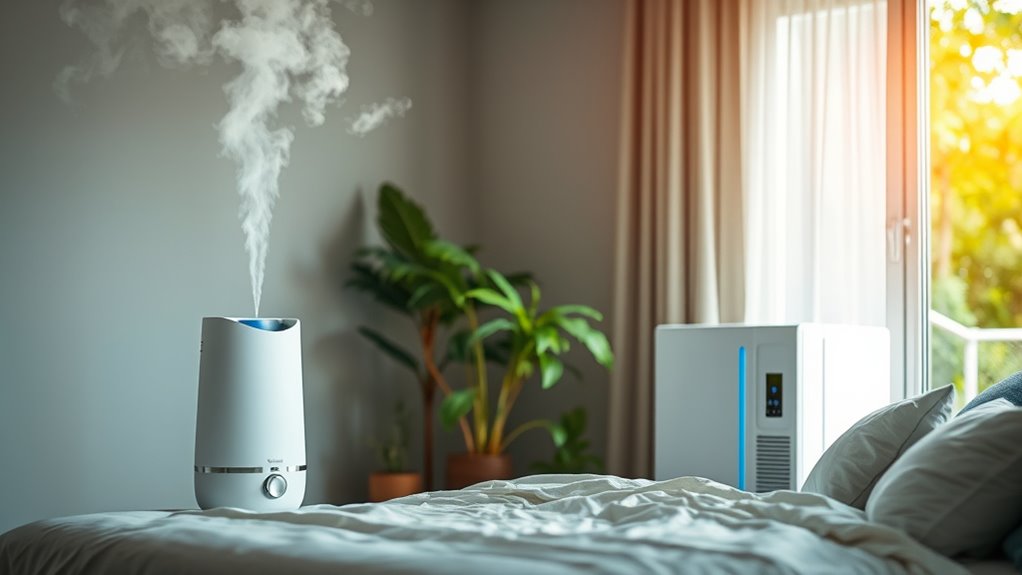Keeping indoor humidity levels between 30% and 50% is key to supporting your respiratory health. If it’s too dry, your airways become irritated, increasing allergy and infection risks. Too humid, and mold can grow, worsening allergy symptoms and breathing problems. Monitoring humidity with a hygrometer helps you sustain a healthy balance. Using humidifiers or dehumidifiers when needed ensures your environment stays comfortable. Continue to explore how proper humidity can improve your breathing comfort and overall health.
Key Takeaways
- Maintaining indoor humidity between 30-50% helps reduce allergy symptoms and respiratory discomfort.
- Low humidity can dry mucous membranes, increasing infection risk and impairing airway defenses.
- Excess humidity promotes mold growth, which releases airborne allergens that worsen asthma and allergies.
- Proper humidity control prevents mold, dust buildup, and condensation that can irritate the respiratory system.
- Using hygrometers and humidity control devices ensures optimal indoor conditions for respiratory health.
The Impact of Humidity on Breathing Comfort

Humidity levels directly affect how comfortably you breathe. When humidity is balanced, indoor plant effects can improve air quality and create a more comfortable environment. Proper humidity supports the growth of healthy indoor plants, which naturally filter the air and boost oxygen levels. Good air circulation importance becomes clear because it helps distribute moisture evenly, preventing stale or overly dry air. If the air is too dry, your respiratory passages may become irritated, making breathing uncomfortable. Conversely, too much humidity can promote mold and dust mites, complicating respiratory health. Maintaining ideal humidity ensures that your indoor environment supports your breathing comfort. Ensuring proper air circulation and considering indoor plant effects are key steps toward creating a space that promotes easier, healthier breathing. Additionally, mindfulness techniques can help you become more aware of your breathing patterns and identify discomfort early, promoting better respiratory health.
How Low Humidity Affects Respiratory Tracts

When indoor air becomes too dry, your respiratory tracts can suffer significant discomfort and impairment. The effects of dry air include irritated mucous membranes, which can lead to a sore throat, dry cough, and difficulty breathing. Breathing in dry environments causes your airways to become inflamed and less effective at trapping dust, allergens, and pathogens. This increases your vulnerability to infections and worsens existing respiratory conditions like asthma. Additionally, dry air reduces mucus production, making it harder to clear irritants from your lungs. Over time, persistent low humidity can weaken your respiratory defenses, leading to increased discomfort, congestion, and susceptibility to illness. Maintaining adequate humidity levels helps keep your respiratory tracts moist, healthy, and better equipped to defend against external irritants. Recognizing the importance of spiritual guidance can also help in understanding how environmental factors influence overall well-being.
The Risks of Excessive Humidity and Mold Growth

When humidity levels get too high, mold can quickly take hold in your home. This mold growth can cause respiratory irritation and worsen allergies or asthma. Understanding these risks helps you keep your environment safe and healthy.
Mold Proliferation Risks
Excessive humidity creates an ideal environment for mold to thrive, posing serious health risks. Mold releases airborne allergens that can trigger allergies, asthma, and other respiratory issues. Using humidity sensors helps you monitor indoor moisture levels and prevent mold growth. High humidity promotes mold proliferation on walls, ceilings, and furniture, making it harder to control indoor air quality. Be alert for signs like musty odors, visible mold patches, or increased allergy symptoms. Regular ventilation and dehumidification reduce mold risks by limiting moisture. Mold spores can settle on surfaces, spreading allergens throughout your home. Keeping humidity levels below 60% minimizes mold proliferation and improves respiratory health. Stay proactive by maintaining suitable humidity and cleaning mold-prone areas promptly to protect yourself from airborne allergens. Incorporating humidity monitoring devices into your routine can further aid in maintaining optimal indoor conditions.
Respiratory Irritation Factors
High humidity levels can directly irritate your respiratory system by promoting mold growth and increasing airborne allergens. Excess moisture creates an environment where mold thrives, which can worsen humidity and allergies, leading to coughing, wheezing, or throat irritation. Mold spores and dust mites become more airborne, heightening the risk of respiratory irritation and allergic reactions. This can compromise your respiratory infection prevention efforts, making you more vulnerable to illnesses. Maintaining ideal humidity levels helps reduce mold proliferation and airborne allergens, supporting better respiratory health. Avoiding excessive humidity not only minimizes irritation but also creates a healthier indoor environment. Monitoring humidity and addressing excess moisture promptly are essential steps in protecting your respiratory system from these irritants. Incorporating sensory toys that promote tactile engagement can also help reduce stress and improve overall respiratory health in sensitive individuals.
Humidity and Asthma: What You Need to Know

Humidity levels can directly affect your asthma by irritating your airways or triggering symptoms. Maintaining balanced indoor moisture helps keep your breathing comfortable and reduces flare-ups. Recognizing signs of humidity imbalance allows you to take quick action to protect your respiratory health. Using performance cookies can help monitor environmental factors that influence indoor humidity and air quality.
Humidity’s Impact on Airways
When humidity levels fluctuate, your airways respond accordingly, affecting your breathing and overall respiratory health. High humidity can cause airway inflammation, making your airways swell and narrow, which worsens breathing. It also increases mucus production, leading to congestion and coughing. Conversely, low humidity can dry out your mucous membranes, making it harder for your airways to trap and clear irritants. This can trigger asthma symptoms or worsen existing conditions. Studies indicate noticeable improvements in pore size with consistent use. Excess moisture promotes mold growth, irritating your airways. Dry air strips mucus, reducing your defenses against infections. Fluctuations cause airway irritation and sensitivity. Increased mucus production can block airflow. Inflammation heightens your asthma attack risk.
Managing Indoor Moisture Levels
Controlling indoor moisture levels is essential for managing asthma symptoms and maintaining healthy airways. To do this, you can perform DIY maintenance like fixing leaks, sealing windows, and using exhaust fans. Adjusting humidity with dehumidifiers or humidifiers helps keep levels between 30-50%. Incorporating indoor plants can improve air quality without raising humidity excessively; choose varieties like spider plants or peace lilies. Be mindful, however, that overwatering plants can raise moisture levels unexpectedly. Use the table below to understand how different indoor factors influence moisture balance:
| Factor | Action | Effect |
|---|---|---|
| Leaks & condensation | Repair immediately | Reduces excess moisture |
| Indoor plants | Proper watering practices | Maintains stable humidity |
| Ventilation | Use exhaust fans & open windows | Prevents dampness |
Additionally, selecting beneficial plants that do not require frequent watering can help maintain optimal indoor humidity levels.
Signs of Humidity Imbalance
Monitoring indoor moisture levels helps you spot early signs that your environment might be affecting your respiratory health. If humidity sensors detect imbalances, you may notice symptoms indicating poor moisture control. Signs of humidity imbalance include increased allergy symptoms, mold growth, and musty odors. You might also experience frequent dust buildup or condensation on windows and walls. Excess humidity can trigger asthma flare-ups, while too little moisture causes dry throat and nasal irritation. Keep an eye out for persistent respiratory discomfort or allergy-like symptoms. Proper moisture control is essential to prevent these issues. Regularly checking humidity levels with sensors helps you maintain ideal indoor conditions and protect your respiratory health. Staying alert to these signs allows you to take timely action and improve your indoor environment. Additionally, understanding city dynamics can help you create a healthier living space suited to your environment.
Optimal Indoor Humidity Levels for Respiratory Health

Maintaining the right indoor humidity levels is essential for supporting respiratory health. Ideally, you should keep indoor humidity between 30% and 50%. Proper humidity measurement helps you monitor levels accurately, ensuring your environment promotes good indoor air quality. When humidity is too low, your nasal passages and lungs can become dry, increasing susceptibility to irritation and infections. Conversely, high humidity fosters mold and dust mites, which can worsen respiratory issues. Using a hygrometer allows you to regularly check humidity levels and adjust accordingly. Staying within this suitable range supports clearer breathing, reduces allergy symptoms, and keeps your respiratory system functioning smoothly. By maintaining balanced humidity, you create a healthier indoor environment that benefits your respiratory health daily.
Strategies to Control Humidity in Your Environment

To effectively manage indoor humidity, start by using tools like a hygrometer to regularly check levels. This helps you stay within the ideal range for respiratory health. You can implement DIY moisture control methods, such as opening windows to promote natural dehumidification or using houseplants that absorb excess moisture.
Consider these strategies:
- Use exhaust fans in bathrooms and kitchens
- Place moisture absorbers like silica gel or activated charcoal
- Maintain proper ventilation throughout your home
- Install window vents or air exchange systems
- Utilize natural dehumidification techniques like dehumidifying houseplants or salt bowls
These simple steps help keep humidity in check, reducing mold growth and respiratory irritants. Combining DIY solutions with proper airflow creates a healthier indoor environment.
Recognizing Signs of Unhealthy Humidity Conditions

When humidity levels become unbalanced, signs of unhealthy conditions often become noticeable in your home. Poor air quality can lead to increased allergic reactions, coughing, or sneezing. You might notice musty odors or visible mold growth, indicating excessive moisture. Conversely, very low humidity can cause dry skin and irritation. To identify these signs quickly, check the following:
| Symptom | Cause | Action Needed |
|---|---|---|
| Musty smell | Excess humidity/mold | Ventilate and reduce moisture |
| Dry skin | Low humidity | Use a humidifier |
| Increased allergies | Poor air quality | Clean filters, improve ventilation |
| Visible mold | Excess moisture | Remove mold, control humidity |
Maintaining optimal humidity levels can also prevent the growth of mold or bacteria, protecting your respiratory health. Recognizing these signs helps you maintain healthy humidity levels and protect your respiratory health.
The Role of Humidifiers and Dehumidifiers in Respiratory Well-being

Humidifiers and dehumidifiers play a crucial role in supporting your respiratory health by helping to maintain ideal indoor humidity levels. Proper use guarantees your environment stays comfortable and reduces respiratory irritation. Regular humidifier maintenance is essential to prevent mold and bacteria buildup, which can worsen breathing issues. When using a dehumidifier, correct placement is key—place it in damp areas like basements to effectively reduce excess moisture. Keep these devices clean and well-maintained to maximize their benefits. Proper humidity levels can ease congestion, protect your lungs, and prevent mold growth. Adjusting humidity with these devices helps create a healthier indoor space, especially during dry winters or humid summers. Staying mindful of maintenance and placement ensures your respiratory well-being stays protected year-round. Additionally, AI-powered sensors can help monitor and optimize indoor humidity levels more accurately.
Frequently Asked Questions
How Does Humidity Influence the Transmission of Respiratory Viruses?
You might wonder how humidity influences virus spread. When humidity is low, airborne droplets evaporate quickly, increasing viral survival and making it easier for respiratory viruses to transmit through droplet transmission. High humidity causes droplets to stay larger and settle faster, reducing airborne viral particles. So, maintaining ideal humidity levels can help minimize the risk of viral survival in the air and decrease the chances of respiratory infections spreading.
Can Humidity Levels Affect Allergy Symptoms Besides Respiratory Issues?
You might notice that humidity levels can influence allergy symptoms beyond respiratory issues. Higher humidity fosters mold growth, which can trigger allergies, while low humidity causes dust to accumulate more easily, aggravating allergy symptoms. Maintaining balanced humidity helps reduce mold and dust, easing your allergy symptoms. So, controlling indoor humidity not only benefits your respiratory health but also minimizes mold and dust-related allergy triggers.
Are There Specific Humidity Ranges for Vulnerable Populations?
Think of your home as a garden where humidity regulation is the gardener. For vulnerable populations, keeping indoor mold at bay requires maintaining humidity between 30-50%. Too high, and mold blossoms; too low, and skin or respiratory issues may arise. By carefully managing humidity, you create a safe environment, preventing mold growth and supporting health, especially for those with sensitivities or pre-existing conditions.
How Does Outdoor Humidity Impact Indoor Air Quality?
Outdoor humidity directly impacts indoor air quality by influencing humidity control inside your space. High outdoor humidity can increase indoor moisture, leading to indoor mold growth if not managed properly. Conversely, low outdoor humidity can cause dryness. To protect your indoor air quality, you should monitor outdoor humidity levels and adjust ventilation or dehumidifiers accordingly, helping prevent indoor mold and maintain a healthy, balanced environment.
What Are the Long-Term Health Effects of Chronic Humidity Imbalance?
Imagine a garden left too damp or too dry; over time, your body faces similar imbalance. Chronic humidity issues can lead to humidifier overuse, which may cause respiratory irritation, or mold growth, risking infections. These long-term effects resemble a garden suffering neglect—thick with unwanted weeds—ultimately weakening your health. To avoid this, maintain proper humidity levels and prevent overuse, safeguarding your respiratory well-being for years to come.
Conclusion
So, next time you’re sweating over humidity levels, remember it’s a fine balance—you’d think avoiding mold and dry throats would be simple, but nope. Sometimes, the quest for perfect air feels like chasing a unicorn. Keep an eye on your environment, and don’t forget: a little humidity control might just save you from sneezing fits and asthma attacks. Ironically, staying healthy could be as easy as adjusting a dial.









